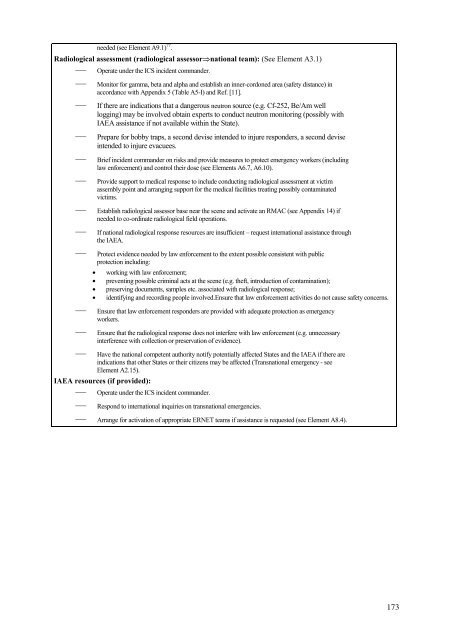epr-method (2003) - IAEA Publications - International Atomic Energy ...
epr-method (2003) - IAEA Publications - International Atomic Energy ...
epr-method (2003) - IAEA Publications - International Atomic Energy ...
Create successful ePaper yourself
Turn your PDF publications into a flip-book with our unique Google optimized e-Paper software.
needed (see Element A9.1) 77 .<br />
Radiological assessment (radiological assessornational team): (See Element A3.1)<br />
— Operate under the ICS incident commander.<br />
— Monitor for gamma, beta and alpha and establish an inner-cordoned area (safety distance) in<br />
accordance with Appendix 5 (Table A5-I) and Ref. [11].<br />
— If there are indications that a dangerous neutron source (e.g. Cf-252, Be/Am well<br />
logging) may be involved obtain experts to conduct neutron monitoring (possibly with<br />
<strong>IAEA</strong> assistance if not available within the State).<br />
— Prepare for bobby traps, a second devise intended to injure responders, a second devise<br />
intended to injure evacuees.<br />
— Brief incident commander on risks and provide measures to protect emergency workers (including<br />
law enforcement) and control their dose (see Elements A6.7, A6.10).<br />
— Provide support to medical response to include conducting radiological assessment at victim<br />
assembly point and arranging support for the medical facilities treating possibly contaminated<br />
victims.<br />
— Establish radiological assessor base near the scene and activate an RMAC (see Appendix 14) if<br />
needed to co-ordinate radiological field operations.<br />
— If national radiological response resources are insufficient – request international assistance through<br />
the <strong>IAEA</strong>.<br />
— Protect evidence needed by law enforcement to the extent possible consistent with public<br />
protection including:<br />
• working with law enforcement;<br />
• preventing possible criminal acts at the scene (e.g. theft, introduction of contamination);<br />
• preserving documents, samples etc. associated with radiological response;<br />
• identifying and recording people involved.Ensure that law enforcement activities do not cause safety concerns.<br />
— Ensure that law enforcement responders are provided with adequate protection as emergency<br />
workers.<br />
— Ensure that the radiological response does not interfere with law enforcement (e.g. unnecessary<br />
interference with collection or preservation of evidence).<br />
— Have the national competent authority notify potentially affected States and the <strong>IAEA</strong> if there are<br />
indications that other States or their citizens may be affected (Transnational emergency - see<br />
Element A2.15).<br />
<strong>IAEA</strong> resources (if provided):<br />
— Operate under the ICS incident commander.<br />
— Respond to international inquiries on transnational emergencies.<br />
— Arrange for activation of appropriate ERNET teams if assistance is requested (see Element A8.4).<br />
173

















